Original article in February 2024
According to the published report entitled Paris Pact Payoff, the additional benefits of the development path consistent with the 1.5°C average global temperature increase threshold far outweigh the costs. Overall, transformation of the energy system, phasing out of carbon-based systems and deployment of renewable-based systems are not a heavy obligation that represents expense, but a source of income.
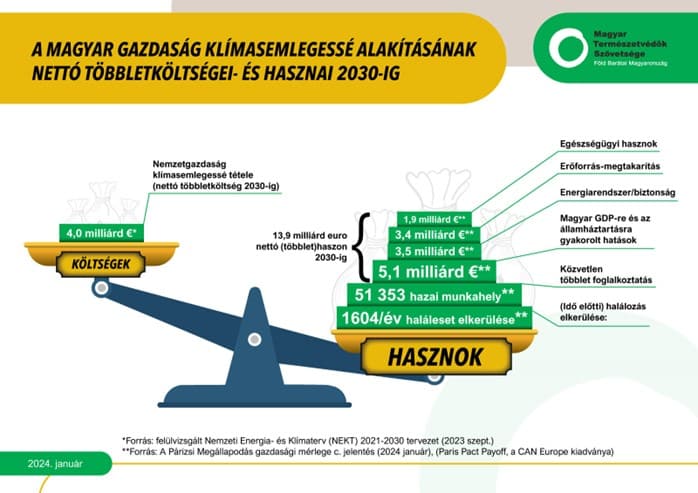
pic_01
Hungary was among the first ones to ratify the Paris Agreement, which regulates climate change mitigation at international level: what should we do to limit global average temperature increase to 1.5 °C? However, more ambitious measures (e.g. fossil fuel phase-out) seem to be postponed until 2030, claiming that they are not urgent but will entail significant costs. This is refuted by the report “Paris Pact Payoff”: the benefits of urgent and necessary climate developments significantly outweigh the costs. The benefits consist of two main parts: avoided losses and co-benefits.
Avoided losses: drought, flood, dust storm
Avoided losses, such as those caused by droughts, forest fires, floods, and dust storms, are often seen as some kind of irreversible blow of fate, an inevitable loss. In fact, most of the time we don’t even see the connection between the construction of a new gas power plant, the dark gray concrete pavement of a huge parking lot, the cutting down of forests, and droughts and unusual flash floods. We don’t see that summer-kind weather in September, the death of the garden thuja bush, the appearance of diseases that previously only occurred along the equator, or the rampant swarms of bedbugs are all symptoms of climate change. And the symptoms are multiplying, while economic losses related to climate are increasing.
Climate-related economic losses, EU27 (1980-2021)
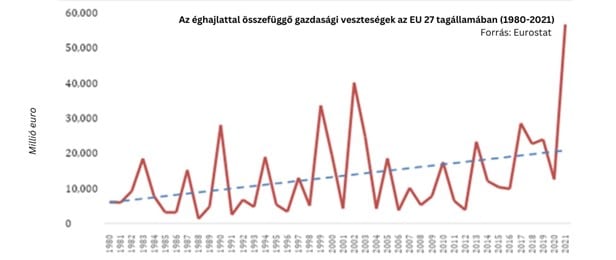
pic_02 (Source: Eurostat)
According to the report of European Environment Agency, “Weather- and climate-related extremes caused economic losses of assets estimated at EUR 738 billion during 1980 – 2023 in the European Union, with over EUR 162 billion (22%) between 2021 and 2023… As severe weather- and climate-related extreme events are expected to intensify further, it seems unlikely that associated economic losses will reduce by 2030.”
Climate damage is also becoming increasingly important in Hungary. In a relevant article, a leading insurance company stated that in 2023, “a record number of property damage claims related to apartments and condominiums were received, exceeding 58,000. Half of the adult Hungarian population (49%) already considers climate change to be one of the biggest future threats. The damage compensation amount for the devastating windstorm that hit the country on February 4, 2022, alone was approximately 350 million Hungarian forints.”
After the dramatic drought of 2022, 2023 may seem peaceful, but the meteorological overview was typically published under the title “2023 the year of big storms”. The study is full of hails, heavy showers, supercell storms, cloudbursts, and more and more wind records. Just as an example, the damage from the storms of August 4-5 is estimated by insurers to be several billion forints nationwide, and this could have set a new record for a single day. As the article summarizes: “2023 was a very eventful year, rich in storms. According to the statement issued by the Association of Hungarian Insurers, such large amounts of storm damage have not occurred in decades.”
“More than a fifth of Hungarian arable land has simply dried up,” said István Nagy, Minister of Agriculture, in the summer of 2022, about the drought. As he said: “extraordinary times require extraordinary solutions in agriculture.” At the same time, the ministry is conspicuously avoiding any discussion that might suggest that currently grown crops should be replaced with crops that can withstand hotter and drier climates. Probably, it would be better to act in time: corn could see a decline of up to 60-80%. Perhaps we should get used to other foods in time, because the crops grown so far will not be able to withstand drought and heat.
The other option, according to the IPCC, is to use nature-based solutions, which offer mutually beneficial adaptation strategy for both food supply and nature. One such option is water retention. Establishment of reservoirs and waterlands brings several benefits at once: in addition to balancing the water flow and alleviating the summer heat, a rarely mentioned feature of wetlands, in addition to their extraordinary biodiversity richness, is that their carbon sequestration capacity is greater than that of any other habitat – emphasized State Secretary András Rácz.
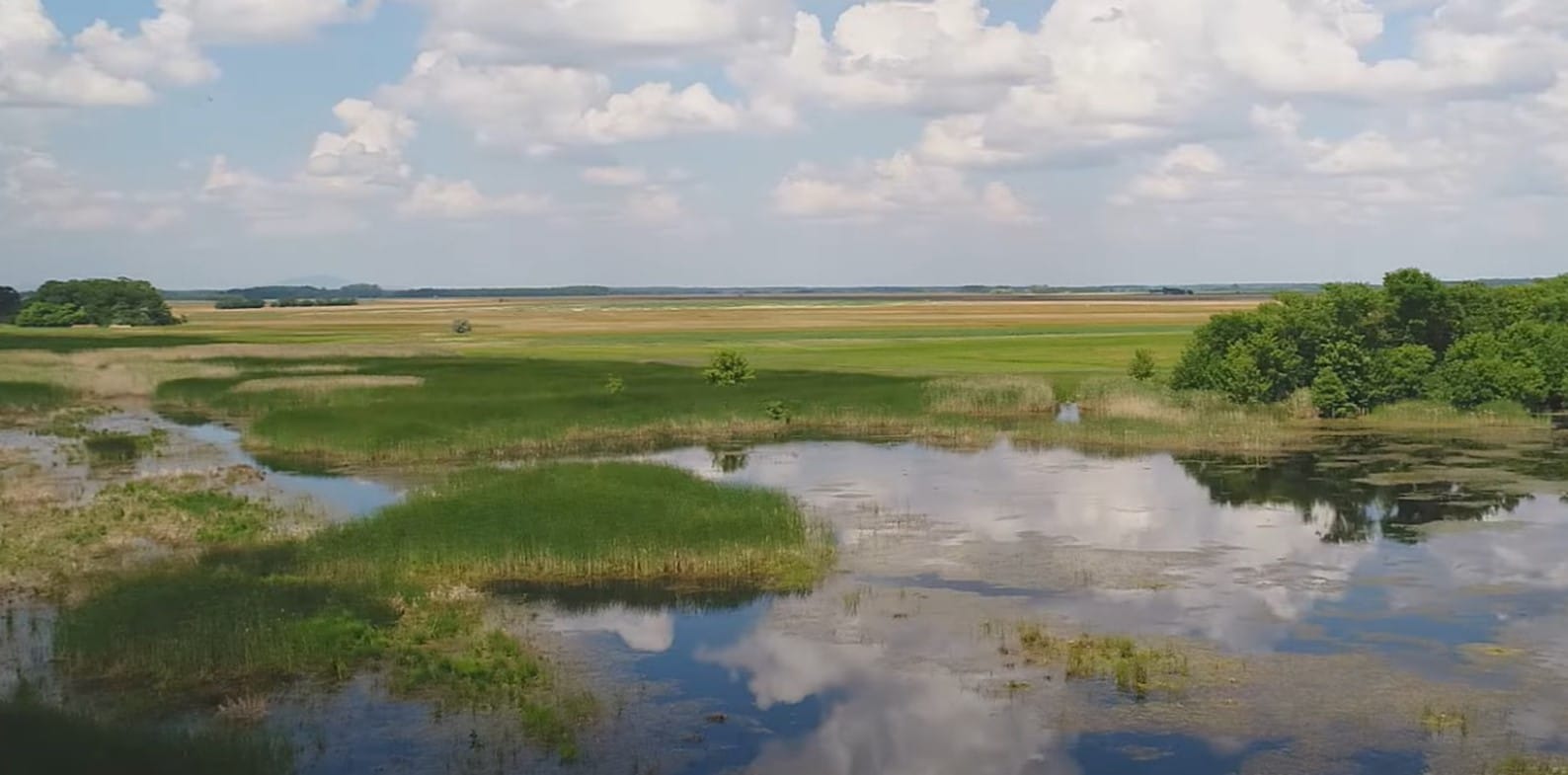
Pic_03 (Scene from the film “Paradise or desert”)
The situation is most critical in the Homokhátság region of Hungary, where desertification can only be addressed and wildlife preserved by developing water retention and upholding the long-term interests of Hungarian farmers, say conservationists.
“Every single penny spent on restoring and protecting nature returns many times over. Natural habitats regulate the climate, vegetation retains water, and extracts carbon dioxide from the air. Overall, whether we can produce food in the future depends on this. When we spend on nature conservation, we spend on economic development.” – said Zsuzsanna Ujj, MTVSZ’s nature conservation program manager, in the film “Paradise or desert” – “The time has passed when one could refer to lack of money when tlking about nature conservation.”
Climate change also brings unexpected surprises. Every practicing parent now learnt that on a hot summer day, we should not let our children near the metal climbing frame on the playground, because the hot pipes can cause serious burns. The appearance of dust storms in Hungary was a similarly unpleasant encounter: in March 2023, a dust storm on the M1 motorway caught motorway operators completely unprepared, and in a matter of seconds, thirty-two cars, five vans and five trucks crashed into each other. This mass accident injured 39 people and killed one person. The incident received significant media coverage, and many emphasized that the formation of dust storms is a tangible result of climate change.
Yes, climate change also claims lives. In the case of a patient who is exhausted and weakened during a heat wave, it is not always clear how much of the death is due to the heat over the days and the persistent lack of adequate rest at night. But, for example, unusual flash floods unfortunately clearly claim victims – also in Hungary.
Present report stresses that “we still have time… to avoid the worst impacts of climate change. We know what needs to be done to achieve this goal: governments must act now to reduce global greenhouse gas emissions by 2030 and accelerate a fair energy transition, phase out fossil fuels and reduce social inequalities.” And all this will bring co-benefits.
Co-benefits: health, jobs, security…
Co-benefits are a kind of by-product of achieving the main climate goals. For example, cleaner air from the phasing out of carbon-based energy systems, which also brings the improvement in human health. Energy efficiency measures are also often mentioned: energy renovation of residential buildings means lower energy bills, healthier living environments and more valuable properties. Climate measures also have a positive impact on employment: they are expected to create 12 million new jobs in Europe, compared to the 1.7 million Europeans who, according to the report, could lose their jobs due to climate change.
Hungary
According to the report, Hungary could save 8.8% of its GDP by 2030 if it increases its climate ambitions as soon as possible and accelerates energy transition and decarbonization to meet the 1.5°C target. Energy savings, wind and other renewable energy initiatives, support for community energy systems, development of public transport, land use and forestry reforms can all serve this purpose.
Although much needs to be done in our country, the benefits are also significant. According to the report, the importance of health is outstanding: Hungary has the second highest cost of illness and death due to exposure to airborne dust in the EU as a proportion of GDP.
According to the report’s calculations, if we were to increase our current policy ambitions to a level that would meet the 1.5°C expectations of the Paris Agreement, Hungary would gain 138 billion euros by 2100.
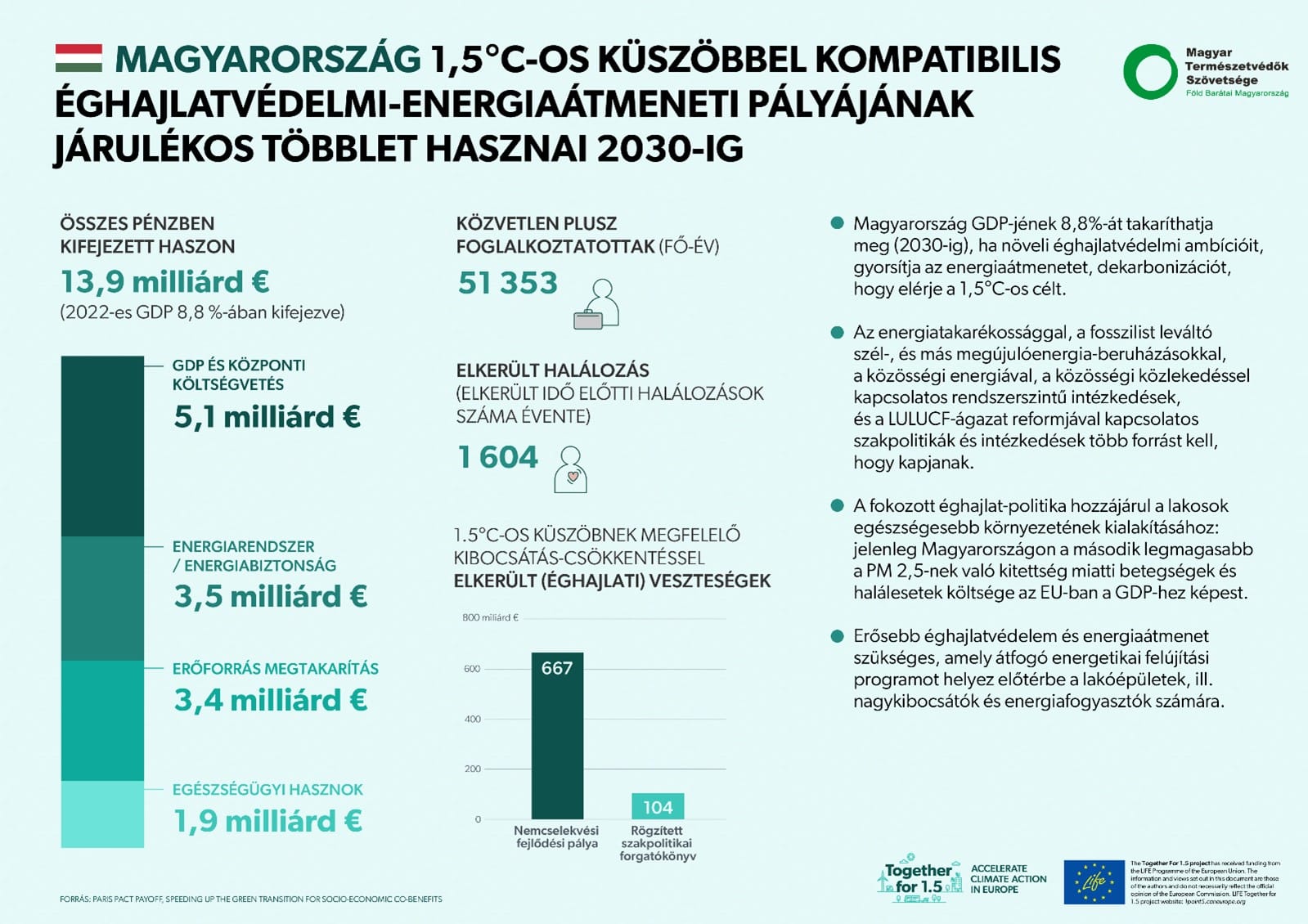
pic_04
Based on Hungarian data, the report calculates a benefit of 13.9 billion euros by 2030. Based on the data of the draft National Energy and Climate Plan for 2023 (page 256), the cost of the necessary energy measures by 2030 is 4.06 billion euros. With a strong but clear simplification, an “investment” of four billion euros will result in fourteen billion euros by the end of the decade.
National Clean Development Strategy: the early bird gets the worm
National Clean Development Strategy 2020-2050 has already considered the costs and benefits of the sustainability transition. In doing so, it stated (page 14) that benefits of the steps outweigh costs, especially if steps are taken as early as possible: “Achieving climate neutrality by 2050 will require significant investments in the coming decades. However, potential medium- and long-term benefits of decarbonizing the national economy outweigh these costs. According to the projections, the complete decarbonization of the Hungarian economy will also generate significant avoided costs and economic benefits. Looking up to 2050, we can see that the value of avoided costs and associated benefits exceeds investment costs… In terms of avoided costs and economic benefits, the Early Action decarbonization scenario (EA) is the most favourable.” According to the document (page 15), implementing the Early Action scenario would result in the creation of a net 182,566 new jobs.
Regarding the newly published report, András Lukács, president of Clean Air Action Group, highlighted in his article that “For decades, the Clean Air Working Group has been preparing detailed recommendations on how to implement an economic policy that simultaneously improves the state of environment, increases competitiveness of national economy, and reduces poverty, but these recommendations have mostly fallen on deaf ears with the governments of the time. We hope that growing evidence will lead to a change in economic policy as soon as possible.”
András Levente Koczóh emphasized that there are plenty of resources that can be used for climate protection until 2030: according to the Green Policy Center’s 2023 proposal, Hungary had approximately 10,600 billion forints of unplanned resources available until the end of 2030. “The efficient use of these abundant resources that also serve long-term climate goals is a key national strategic issue and a once-in-a-lifetime opportunity not only for climate policy, but also for the long-term sustainable social and economic operation of our country,” he writes.
Now we have money, now we face the plan
We have good opportunity for all of this, doubly so. On the one hand, as we wrote above, there are plenty of EU funds available to achieve climate goals. Many investments have positive impact already at the start of operation. For example, appropriate support for the energy renovation of residential buildings, which already brings benefits when investing.
On the other hand, the review of the National Energy and Climate Plan (NECP), which is still ongoing until the end of June 2023, is a great opportunity to increase climate protection ambition. This is not only an environmental issue or a moral dilemma, but, as the new professional report shows, it also brings economic and social benefits of five thousand billion forints.

pic_05 (Scene from the film “Paradise or desert”)
Anyhow, all of this requires decisive steps, and not in the wrong direction. For example, at the beginning of 2023, during the discussion of the details of the NECP, Hungarian government talked about moving towards public transport and towards railways: modernizing infrastructure, replacing rolling stock, organizing timetable. Since then, deterioration of railway tracks has become obvious, which is causing an increase in travel times. The ordeal of Budapest – Hegyeshalom line was only the top of the iceberg. According to a summary, almost two thousand kilometres of railway lines have been closed since the change of regime, and as things stand, there is less and less hope for their reopening. The debate about MÁV and Budapest passes that is currently taking place on the surface, and which is increasingly difficult to follow, shows the complete lack of concept in public transport.
As part of the NECP update, we explained it at the civil society’s national climate and energy policy conference held in October 2023 and on December 14, and we emphasize it now that the state
- Should plan more deep renovations in the building sector and support them with more resources than currently. EU and national resources should enable the energy renovation of an average of 130-140 thousand homes per year, instead of the total of about 60 thousand planned to be renovated by 2029.
- Should increase the share of renewables in the energy mix. The installed capacity of wind energy should be increased by at least half compared to solar panels, and energy communities should be given a greater role.
- Should abolish all direct and indirect (e.g. tax breaks, reduced mining royalties) support for environmentally harmful activities, and should not provide such support in the future either. Forced reindustrialization leads to significant extra greenhouse gas emissions, unsustainable energy demand, and a delayed phase-out of fossil fuel use.
Our proposals are in line with the Commission’s opinion, which highlights, among other things, that Hungary’s draft National Energy and Climate Plan
- postpones the phase-out of lignite, plans to operate the Mátra power plant until 2030 and does not plan to phase out current fossil fuel subsidies;
- does not provide a comprehensive picture of the planned measures in terms of energy efficiency and energy savings;
- does not sufficiently describe the planned steps to diversify energy supply;
- does not set out specific clean energy competitiveness objectives, measures to achieve net-zero industrial policy or to develop the necessary capabilities;
- does not explain the approach to addressing energy poverty, including an assessment of the situation of households and steps to address them.
The Union, EU countries and Hungary
The report highlights that “the EU and its Member States need to take decisive and bold climate action. First, for reasons of fairness. Both the UN Framework Convention on Climate Change (UNFCCC) and the Paris Agreement stress the need for countries to act faster, based on their historical responsibility for greenhouse gas emissions and their economic potential. It is clear that EU has both a historical responsibility and capacity to act faster than others, given its higher-than-average historical emissions and higher-than-average GDP per capita.
Europe is clearly rethinking its climate plans. In June this year, we will elect a new European Parliament, which will shape a new Commission. Some fear that climate and environmental goals will not be achieved because they feel that political forces currently forming will not give them enough space. In the same time, it is particularly encouraging that some European states – including Germany, France and the Netherlands – have expressed their expectation of ambitious 2040 climate goals.
Wonder if Hungary, as the EU presidency state in the second half of 2024, intends to take a firm stand on all this, and if so, what position? We believe that updating of NECP and shaping of 2040 climate targets are great opportunities to increase climate ambition. The recently published report confirmed that taking climate action as soon as possible in line with Paris Agreement is not only an environmental, health or moral obligation, but also a financially rewarding investment. We are looking forward to continuing working together to find common, harmonious solutions that meet different expectations at the same time.
The above article was created within the framework of the Together for 1.5 project. The Together for 1.5 project operates with the support of the LIFE Programme of the European Union. The opinions and statements contained herein reflect the views of the author(s) and do not necessarily correspond to the official position of the European Commission.
- An excerpt from the report entitled “Paris Pact Payoff SPEEDING UP THE GREEN TRANSITION FOR SOCIO-ECONOMIC CO-BENEFITS” on which this article is based can be read in Hungarian here.
- Original report titled “Paris Pact Payoff SPEEDING UP THE GREEN TRANSITION FOR SOCIO-ECONOMIC CO-BENEFITS” on which this article is based can be read in English here.
- Website of the Together for 1.5 project is available here.
- Hungarian page of the Together for 1.5 project is available here.
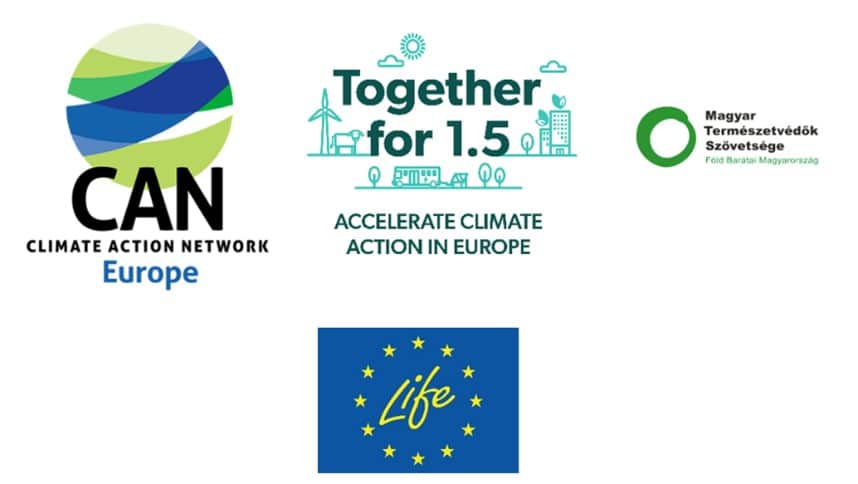
pic_06
#EgyüttAMásfélfokért #TogetherFor1point5 #CDE_EUKI #CAN_LIFE #járulékoshaszon #cobenefits
PREVIOUS
NEXT
